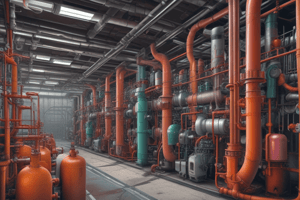Podcast
Questions and Answers
Intrinsic Safety is a design applied to non-electrical equipment for hazardous locations.
Intrinsic Safety is a design applied to non-electrical equipment for hazardous locations.
False (B)
Direct-reading instruments provide information after sampling is done.
Direct-reading instruments provide information after sampling is done.
False (B)
There are five categories of hazardous atmospheres according to the text.
There are five categories of hazardous atmospheres according to the text.
False (B)
Rescue teams cannot determine the gases and vapors present in an atmosphere during an emergency response.
Rescue teams cannot determine the gases and vapors present in an atmosphere during an emergency response.
Gas testing should be done without considering personal protective equipment.
Gas testing should be done without considering personal protective equipment.
Gas detection equipment should be selected based on general needs rather than the specific needs of the incident.
Gas detection equipment should be selected based on general needs rather than the specific needs of the incident.
Cross Sensitivity refers to a sensor's reaction to the target gas only.
Cross Sensitivity refers to a sensor's reaction to the target gas only.
Acetylene can interfere with instrument sensors and mask the presence of carbon monoxide (CO).
Acetylene can interfere with instrument sensors and mask the presence of carbon monoxide (CO).
Response Time indicates how quickly a gas detection instrument reacts to its specific gas.
Response Time indicates how quickly a gas detection instrument reacts to its specific gas.
Noise/Drift measures the fluctuation of readings when the quantity or concentration of a substance changes.
Noise/Drift measures the fluctuation of readings when the quantity or concentration of a substance changes.
Limit of Detection (LOD) is the highest concentration of a substance that the instrument can measure accurately.
Limit of Detection (LOD) is the highest concentration of a substance that the instrument can measure accurately.
Precision refers to how well repeated measurements under unchanged conditions give different results.
Precision refers to how well repeated measurements under unchanged conditions give different results.
Gas testing during underground exploration should be performed only when conditions change.
Gas testing during underground exploration should be performed only when conditions change.
Sampling at the top, middle, and bottom of a space must be done every 5-10 meters.
Sampling at the top, middle, and bottom of a space must be done every 5-10 meters.
Bump testing is considered the most important element of gas detector maintenance.
Bump testing is considered the most important element of gas detector maintenance.
It is recommended to perform a bump test on gas detectors weekly.
It is recommended to perform a bump test on gas detectors weekly.
Bump tests are conducted to measure the accuracy of the gas detectors.
Bump tests are conducted to measure the accuracy of the gas detectors.
If an instrument fails during a bump test, a full calibration is necessary before use.
If an instrument fails during a bump test, a full calibration is necessary before use.
Electronic gas detectors do not need to meet any manufacturer standards
Electronic gas detectors do not need to meet any manufacturer standards
Gas tube testers have a limited shelf-life
Gas tube testers have a limited shelf-life
The chip used in gas tube testers can be reused multiple times
The chip used in gas tube testers can be reused multiple times
Electronic gas detectors can be both portable and non-portable
Electronic gas detectors can be both portable and non-portable
Gas tube testers are accurate within +/- 10%
Gas tube testers are accurate within +/- 10%
Gas tube testers come with an alarm system for continuous monitoring
Gas tube testers come with an alarm system for continuous monitoring
Calibration gas cylinders are identified by Gases and Concentrations, Part Number, and Expiration Date.
Calibration gas cylinders are identified by Gases and Concentrations, Part Number, and Expiration Date.
It is recommended to perform full instrument calibration using calibration gas(es) monthly to ensure maximum accuracy.
It is recommended to perform full instrument calibration using calibration gas(es) monthly to ensure maximum accuracy.
Clearing the peaks is not necessary when performing a Bump Test Procedure.
Clearing the peaks is not necessary when performing a Bump Test Procedure.
The calibration process uses a calibration gas with a random concentration.
The calibration process uses a calibration gas with a random concentration.
Establishing a point of measurement accuracy is not one of the benefits of calibration.
Establishing a point of measurement accuracy is not one of the benefits of calibration.
When using regulators for disposable gas cylinders, it is not necessary to follow the manufacturer's recommendations.
When using regulators for disposable gas cylinders, it is not necessary to follow the manufacturer's recommendations.
Study Notes
Gas Detection Instruments
- There are four categories of hazardous atmospheres: toxic, oxygen deficiency/asphyxiating gases, explosive/flammable gases or vapours, and smoke, aerosols, fumes (particulate contaminants).
Intrinsic Safety
- Intrinsic safety is a design applied to electrical equipment and wiring for hazardous locations.
- It limits energy, both electrical and thermal, to a level below that required to ignite a specific hazardous atmospheric mixture.
Selecting Gas Detection Equipment
- Gas detection equipment must be selected based on the specific needs of the incident.
- Mine rescue gas detection involves the use of direct-reading instruments (DRI).
- All equipment must meet relevant health and safety legislation, standards, and regulations.
Performance Criteria/Specifications
- Response time: ability to react to its specific gas in the specified time (e.g., 90% of reading in 30 seconds).
- Noise/drift: how much readings fluctuate when the quantity or concentration of a substance stays the same.
- Limit of detection (LOD): the lowest quantity or concentration of a substance that the instrument can register within a margin of confidence.
- Accuracy: the degree to which the measurement of a quantity of a substance matches up with that quantity's actual value.
- Precision: the degree to which repeated measurements under unchanged conditions show the same results.
- Dynamic range: the ratio between the largest and smallest possible signals.
Limitations of Tubes and Pumps
- Tubes and pumps are manufacturer-specific.
- No alarm system, therefore not recommended for continuous monitoring.
- Dependent upon operator's interpretation of results.
- Application can require longer periods of time in atmospheres for results to appear (up to several minutes).
- Limited shelf-life.
- Only accurate within +/- 20%.
- Many cross-sensitivities.
Types of Detectors
- Drager, Gastec, and CMS are common types of detectors.
- Electronic gas detectors are complex systems that include a sensor(s), alarms, a battery, and a display.
- They are available as single, multi-gas, stationary (non-portable), and specialized units.
Gas Testing
- During underground exploration, gas testing should be performed at intersections or where conditions change.
- Sampling at the top, middle, and bottom of a space must be done in accordance with manufacturer specifications.
- Sample every 1-2 meters (3-7 ft) due to the weights of gases.
Bump Testing and Calibration
- Bump testing and calibration are essential elements of gas detector maintenance.
- Functional ("bump") testing involves a brief exposure of the monitor to a known concentration of gas(es) to verify sensor and alarm operation.
- Manufacturers recommend that a bump test be performed on every instrument prior to each day's use.
- Calibration ensures that detectors perform properly and provides insight into the condition of the sensors in the instrument.
- Calibration gas cylinders are certified and traceable mixtures of gas concentration.
Steps for Gas Detector Operation
- Visually inspect for damage and contamination.
- Turn on the instrument in good atmosphere and check battery level.
- Zero the instrument.
- Bump test (functionally check) the instrument.
- Clear the peaks if applicable.
Studying That Suits You
Use AI to generate personalized quizzes and flashcards to suit your learning preferences.
Related Documents
Description
Learn about the various limitations of gas detection tubes and pumps, including manufacturer-specific equipment, lack of alarm systems, operator interpretation dependence, longer wait times for results, limited accuracy, cross-sensitivities, and environmental factors affecting application range. Understand the importance of proper storage, handling, and disposal.




